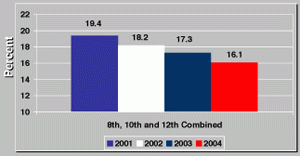The Overall Picture of Drug Abuse in the United States is Constantly Changing
NIDA monitors drug use patterns and trends and uses the power of science to prevent emerging drug problems from becoming national epidemics.
17% Decline 2001 to 2004*
 *P < .05
*P < .05Source: Johnston et al., 20041
NIDA’s long-standing Monitoring the Future (MTF) survey shows that there has been an approximately 17% decline over the last three years in any illicit drug use in the past month by students in the eighth, tenth, and twelfth grades combined.
Ecstasy Use Declines Among Teens
 Source: Johnston et al., 20041
Source: Johnston et al., 20041The use of MDMA or Ecstasy decreased significantly in all grades between 2002 and 2003. Between 2003 and 2004 lifetime use declined significantly for 10th graders going from 5.4% to 4.3%.
Tobacco Use Declines Among Teens
 Source: Johnston et al., 20041
Source: Johnston et al., 20041The use of nicotine has also decreased in youth--it is at its lowest rate in the history of the survey, and continues a trend that began in 1997. This is particularly notable since nicotine is often used before any other drugs of abuse, and tobacco addiction is one of the leading contributors to many of our Nation's public health problems.
Despite Good News Drug Abuse Continues
The National Survey on Drug Use and Health (NSDUH) supported by the Substance Abuse and Mental Health Services Administration also tracks drug use in populations aged 12 and older. Both surveys (MTF and NSDUH) indicate that disturbing patterns in overall drug use are still evident.
- An estimated 19.5 million Americans aged 12 or older were current users of an illicit drug in 2003. This estimate represents 8.2 percent of the population.2
- Over half (51%) of America’s teenagers have tried an illicit drug by the time they finish high school.1
- An estimated 71 million Americans reported being current users of a tobacco product in 2003, a prevalence rate of 30% for the population 12 years and older.2
- Marijuana is the most widely used illicit substance in this country. In 2003, 14.6 million people were current users of marijuana.2
- For the second year in a row inhalant use has increased in 8th graders with 17.3% reporting use at least once in their lifetime. These drugs are particularly dangerous because they can damage the nervous system even after a single use, and they can be fatal.1
Prescription Drug Abuse Alert:
Vicodin is one of the drugs most commonly abused by high school seniors. Nearly one in ten 12th graders reported non-medical use of Vicodin in 2004; one in twenty 12th graders reported non-medical use of OxyContin.1
